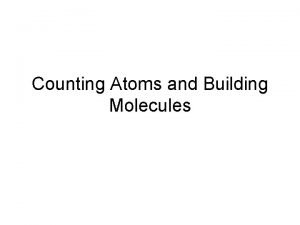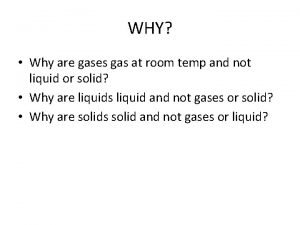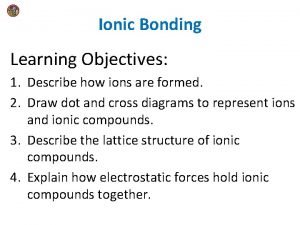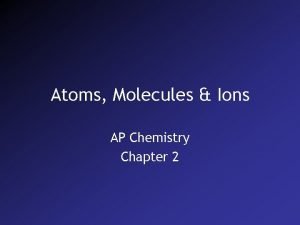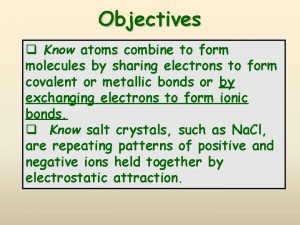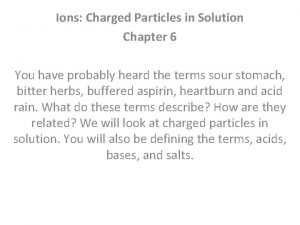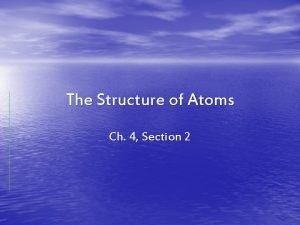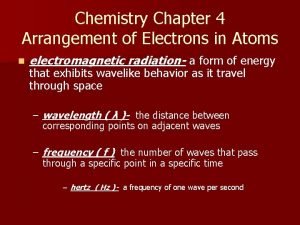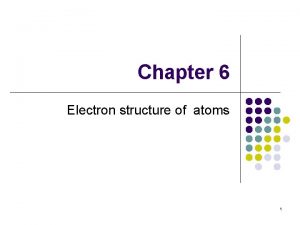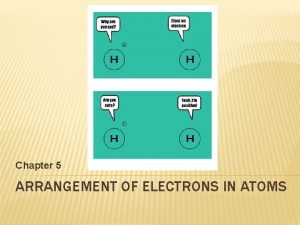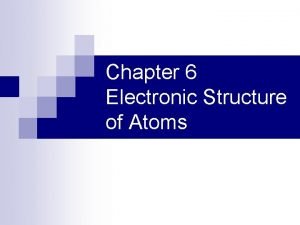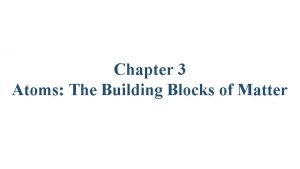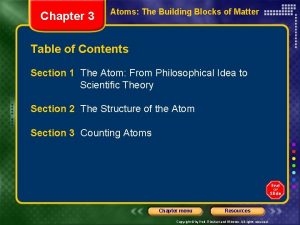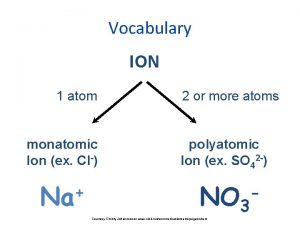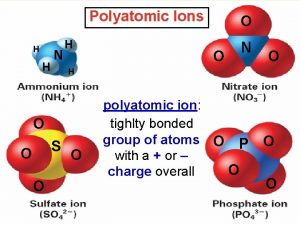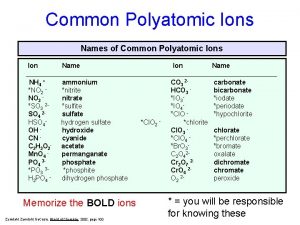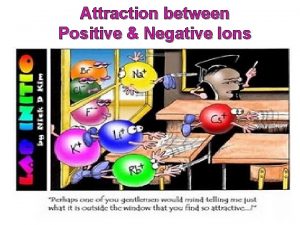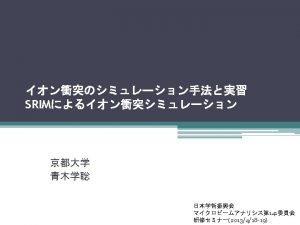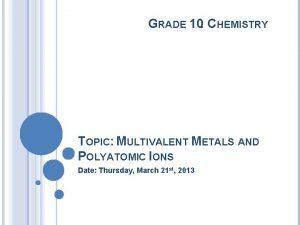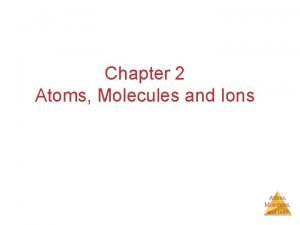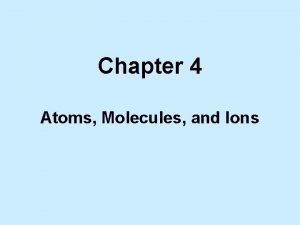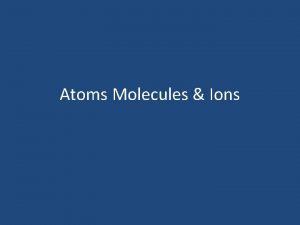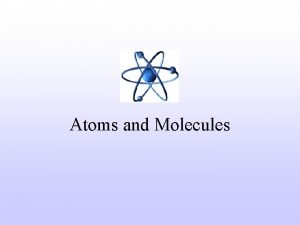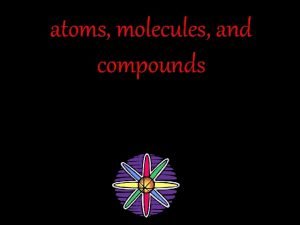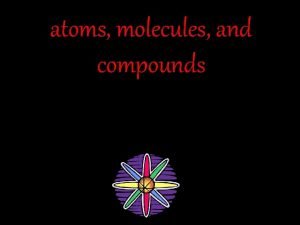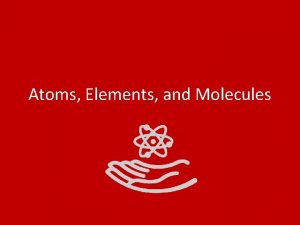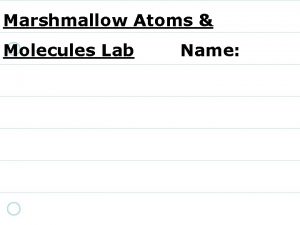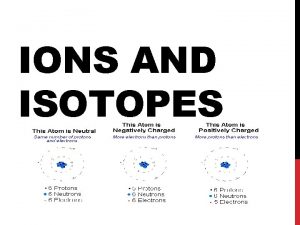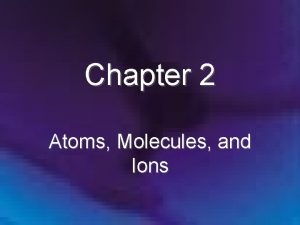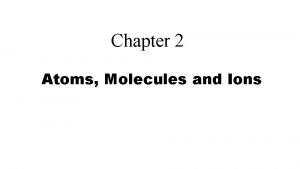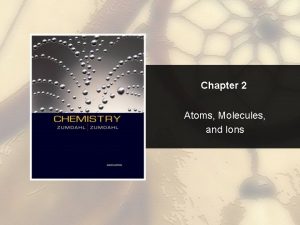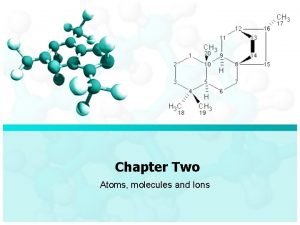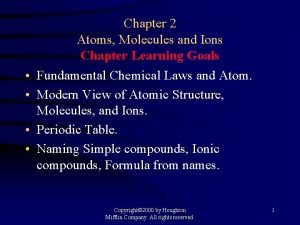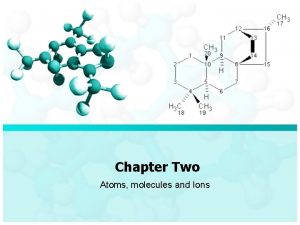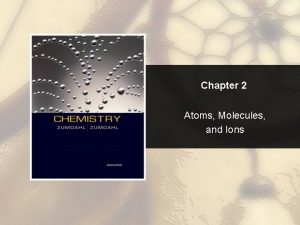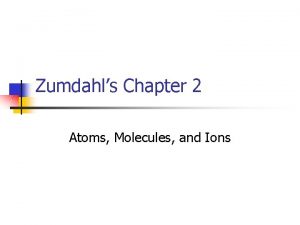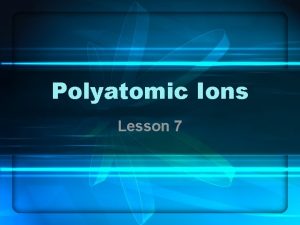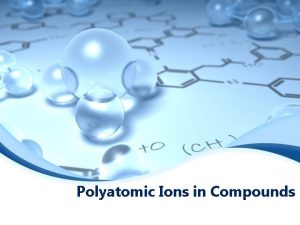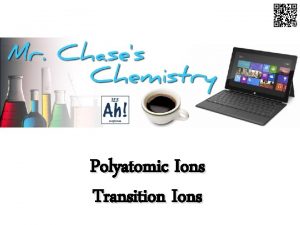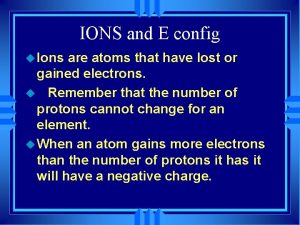Chapter 2a Atoms Molecules and Ions Chapter 2





































- Slides: 37

Chapter 2(a) Atoms, Molecules, and Ions

Chapter 2 Atoms, Molecules, and Ions • 2. 1 • 2. 2 • 2. 3 • 2. 4 • 2. 5 • 2. 6 The Early History of Chemistry Fundamental Chemical Laws Dalton’s Atomic Theory Cannizzaro’s Interpretation Early Experiments to Characterize the Atom The Modern View of Atomic Structure: An Introduction • 2. 7 Molecules and Ions • 2. 8 An Introduction to the Periodic Table • 2. 9 Naming Simple Compounds 歐亞書局 2|2

Gecko on a Trochetia flower on the tropical island of Mauritius. 歐亞書局 2|3

2. 1 The Early History of Chemistry – Robert Boyle (1627 - 1691) : – Georg Stahl (1660 - 1734) : – Joseph Priestley (1733 - 1804) : 歐亞書局 2|4

Priestley Medal Source: Roald Hoffman, Cornell University 歐亞書局 2|5

2. 2 Fundamental Chemical laws – Antoine Lavoisier (1743 - 1794), a French chemist (Fig. 2. 1). – Lavoisier’s discovery of this law of conservation of mass was the basis for the developments in chemistry in the nineteenth century. 歐亞書局 2|6

FIGURE 2. 1 Antoine Lavoisier with his wife. 歐亞書局 2|7

– Joseph Proust (1754 - 1826), showed that a given compound always contains exactly the same proportion of elements by mass. – The principle of the constant composition of compounds, originally called Proust’s law, is now known as the law of definite proportion. – John Dalton (1766 - 1844), an English schoolteacher (Fig. 2. 2) 歐亞書局 2|8

FIGURE 2. 2 John Dalton(1766 -1844) Source: Manchester Literary & Philosophical Society 歐亞書局 2|9

– law of multiple proportions:When two elements form a series of compounds, the rations of the masses of the second element that combine with 1 gram of the first element can always be reduced to small whole numbers. 歐亞書局 2 | 10


– The significance of these data is that compound I contains twice as much nitrogen (N) per gram of oxygen (O) as does compound II and that compound II contains twice as much nitrogen per gram of oxygen as does compound III. In terms of the numbers of atoms combining, these data can be explained by any of the following sets of formulas: 歐亞書局 2 | 12

2. 3 Dalton’s Atomic Theory – In 1808 Dalton published A New system of Chemical Philosophy, in which he presented his theory of atoms: Dalton’s Model • • 歐亞書局 1. Each element is made up of tiny particles called atoms. 2. The atoms of a given element are identical; the atoms of different elements are different in some fundamental way or ways. 3. Chemical compounds are formed when atoms combine with each other. A given compound always has the same relative numbers and types of atoms. 4. Chemical reactions involve reorganization of the atomschanges in the way they are bound together. The atoms themselves are not changed in a chemical reaction. 2 | 13

– Dalton prepared the first table of atomic masses (formerly called atomic weights by chemists, since mass is usually determined by comparison to a standard mass-a process called weighing*). – Although not recognized as such for many years, the keys to determining absolute formulas for compounds were provided in the experimental work of the French chemist Joseph Gay - Lussac (1778 1850) and by the hypothesis of an Italian chemist named Amedeo Avogadro (1776 1856). 歐亞書局 2 | 14

Joseph Louis Gay - Lussac 歐亞書局 2 | 15

– In 1809 Gay - Lussac performed experiments in which he measured (under the same conditions of temperature and pressure ) the volumes of gases that reacted with each other. For example, Gay. Lussac found that 2 volumes of hydrogen react with 1 volume of oxygen to form 2 volumes of gaseous water and that 1 volume of hydrogen reacts with 1 volume of chlorine to form 2 volumes of hydrogen chloride. 歐亞書局 2 | 16

– – – – 歐亞書局 In 1811 Avogadro interpreted these results by proposing that, at the same temperature and pressure, equal volumes of different gases contain the same number of particles. This assumption (called Avogadro’s hypothesis) makes sense if the distances between the particles in a gas are very great compared with the sizes of the particles. 2 | 17

– Gay - Lussac’s results can then be represented as shown in Fig. 2. 3. (Note that this reasoning suggests that the formula for water is H 2 O, not OH as Dalton believed. ) 歐亞書局 2 | 18

FIGURE 2. 3 A representation of combining gases at the molecular level. The spheres represent atoms in the molecules and the boxes represent the relative volumes of the gases. 歐亞書局 2 | 19

2. 4 Cannizzaro’s Interpretation – Cannizzaro was guided by two main beliefs. • • 歐亞書局 1. Compounds contained whole numbers of atoms as Dalton postulated. 2. Avogadro’s hypothesis was correct-equal volumes of gases under the same conditions contain the same number of molecules. 2 | 20

– The tip movements are recorded by a computer and can be turned into an elevation map, like that shown in Fig. 2. 4. – The tip can also be used to move atoms around on the surface, as illustrated by the elliptical arrangement of cobalt atoms shown in Fig. 2. 5. 歐亞書局 2 | 21

FIGURE 2. 4 An STM image of nickel atoms placed on a copper surface. Source: IBM Research 歐亞書局 2 | 22

FIGURE 2. 5 Image of a ring of cobalt atoms placed on a copper surface. Source: IBM Research 歐亞書局 2 | 23

– 歐亞書局 Cannizzaro addressed this problem by obtaining the relative molecular masses of many other compounds containing carbon. For example, consider the data shown in Table 2. 1. 2 | 24

Example 2. 1 • The first four compounds listed in Table 2. 1 contain only carbon and hydrogen. Predict the formulas for these compounds. – Solution • Since the compounds contain only carbon and hydrogen, the percent hydrogen in each compound (by mass) is 100 -% carbon. We can then find the relative mass of hydrogen present as follows: • Relative mass of hydrogen=percent hydrogen/100 * relative molecular mass 歐亞書局 2 | 25

• 歐亞書局 In tabular form the results are as follows: 2 | 26

• 歐亞書局 Combining the above results with those from Table 2. 1, we find that methane contains relative masses of carbon and hydrogen of 12 and 4, respectively. Using the relative atomic mass values of 12 and 1 for carbon and hydrogen gives a formula of CH 4 for methane. Similarly, the relative masses of carbon and hydrogen in ethane of 24 and 6, respectively, lead to a formula of C 2 H 6 for ethane. Similar reasoning gives formulas for propane and butane of C 3 H 8 and C 4 H 10, respectively. 2 | 27

Stanislao Cannizzaro Source: Corbis 歐亞書局 2 | 28

2. 5 Early Experiments to Characterize the Atom • The Electron – The first important experiments that led to an understanding of the composition of the atom were done by the English physicist J. J. Thomson (1856 - 1940), who studied electrical discharges in partially evacuated tubes called cathode-ray tubes (Fig. 2. 6) during the period from 1898 to 1903. 歐亞書局 2 | 29

FIGURE 2. 6 (a) A cathode-ray tube. The fast-moving electrons excite the gas in the tube, causing a glow between the electrodes. The green color in the photo is due to the response of the screen (coated with zinc sulfide) to the electron beam. 歐亞書局 2 | 30

FIGURE 2. 6 (b) A cathode-ray tube. 歐亞書局 2 | 31

– Thomson found that when high voltage was applied to the tube, a ”ray” he called a cathode ray (because it emanated from the negative electrode, or cathode) was produced. Because this ray was produced at the negative electrode and was repelled by the negative pole of a applied electric field (see Fig. 2. 7), Thomson postulated that the ray was a stream of negatively charged particles, now called electrons. 歐亞書局 2 | 32

FIGURE 2. 7 Deflection of cathode rays by an applied electric field. 歐亞書局 2 | 33

– Thomson postulated that an atom consisted of a diffuse cloud of positive charge with the negative electrons embedded randomly in it. This model, shown in Fig. 2. 8, is often called the plum pudding model. 歐亞書局 2 | 34

FIGURE 2. 8 Thomson's plum pudding model. 歐亞書局 2 | 35

– In 1909 Robert Millikan (1868 - 1953), working at the University of Chicago, performed very clever experiments involving charged oil drops. These experiments allowed him to determine the magnitude of the electron charge (see Fig. 2. 9). – Mass of the electron as 9. 11*10 -31 kilogram 歐亞書局 2 | 36

FIGURE 2. 9 A schematic representation of the apparatus Millikan used to determine the charge on the electron. The fall of charged oil droplets due to gravity can be halted by adjusting the voltage across the two plates. The voltage and the mass of an oil drop can then be used to calculate the charge on the oil drop. Millikan’s experiments showed that the charge on an oil drop is always a whole-number multiple of the electron charge. 歐亞書局 2 | 37
 Chapter 2 atoms molecules and ions
Chapter 2 atoms molecules and ions Ion chapter 11
Ion chapter 11 Atoms molecules and ions
Atoms molecules and ions Atoms molecules and ions
Atoms molecules and ions Atoms molecules and ions
Atoms molecules and ions Atoms ions and molecules
Atoms ions and molecules Atoms ions and molecules
Atoms ions and molecules Collision theory states that
Collision theory states that Carbon trichloride
Carbon trichloride What is the relationship between atoms and elements
What is the relationship between atoms and elements Solution
Solution How can you count atoms and molecules
How can you count atoms and molecules Interacting molecules or ions
Interacting molecules or ions Organic molecules vs inorganic molecules
Organic molecules vs inorganic molecules Magnesium and fluorine ionic compound
Magnesium and fluorine ionic compound Atoms or ions are considered isoelectronic if
Atoms or ions are considered isoelectronic if Atoms combine to form
Atoms combine to form Periodic table of elements regents
Periodic table of elements regents Chapter 6 section 1 atoms elements and compounds answer key
Chapter 6 section 1 atoms elements and compounds answer key Chapter 6 section 1 atoms elements and compounds
Chapter 6 section 1 atoms elements and compounds Chapter 13 review ions in aqueous solutions
Chapter 13 review ions in aqueous solutions Chapter 6 ions charged particles in solution
Chapter 6 ions charged particles in solution Chapter 3 molecules of life
Chapter 3 molecules of life Chapter 4 section 2 the structure of atoms
Chapter 4 section 2 the structure of atoms Chapter 4 arrangement of electrons in atoms test
Chapter 4 arrangement of electrons in atoms test Ccechs
Ccechs Chapter 6 electronic structure of atoms answers
Chapter 6 electronic structure of atoms answers Chapter 5 arrangement of electrons
Chapter 5 arrangement of electrons Which of the d orbitals most resembles a pz orbital?
Which of the d orbitals most resembles a pz orbital? Chapter 3 atoms the building blocks of matter
Chapter 3 atoms the building blocks of matter Chapter 3 atoms the building blocks of matter
Chapter 3 atoms the building blocks of matter What is a monatomic ion
What is a monatomic ion Polyatomic ion
Polyatomic ion Monatomic ions
Monatomic ions Variable charge cations
Variable charge cations Positive negative attract each other
Positive negative attract each other Srim the stopping and range of ions in matter
Srim the stopping and range of ions in matter Multivalent metals definition
Multivalent metals definition











